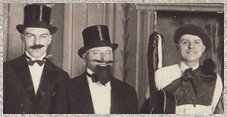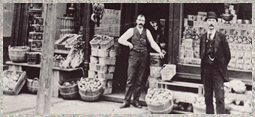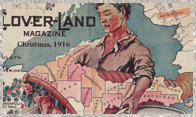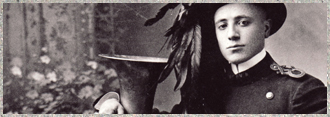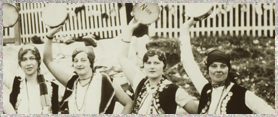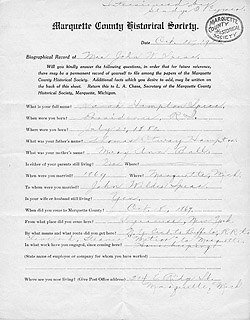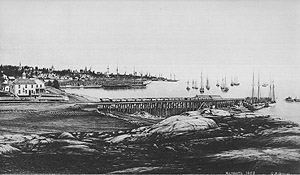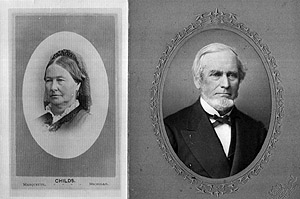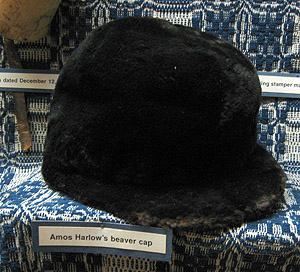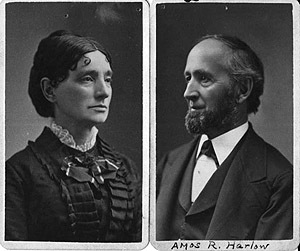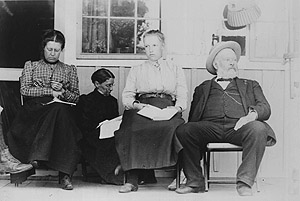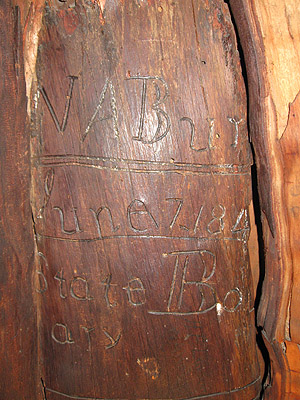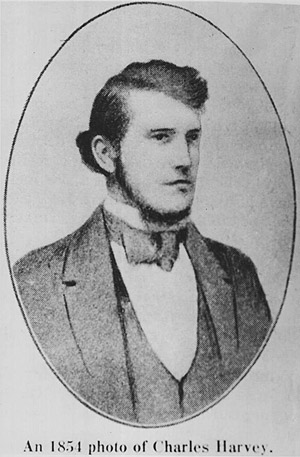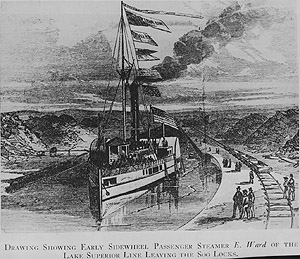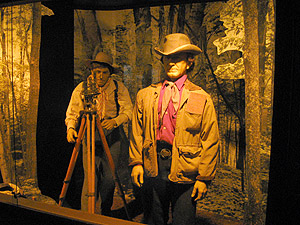Yankees Forge the Way
By: Rosemary Michelin, Librarian
John M. Longyear Research Library
The iron industry in Marquette County, Michigan could not have developed without the financial resources, technical skills and pioneer spirit of the Yankees who settled there in the mid 1800’s. Who were these Yankees? The term “Yankee” was derived from the Dutch words, “Jan Kaas”, which translated as “John Cheese” [1] This was a derogatory nickname applied to English settlers along the eastern seaboard by the Dutch residents of New York. Eventually the phrase was pronounced “Yankee”. This term has evolved in meaning over the years to describe the following people:
A resident of one of the original 13 colonies of the United States
A native or resident of one of the 6 New England states
A native or inhabitant of a northern state
A Union soldier during the Civil War
A native or inhabitant of the United States, by people of other countries, especially the United Kingdom
A New York baseball team
In this discussion, “Yankee” will refer to the inhabitants of the 6 New England states of Maine, Vermont, New Hampshire, Massachusetts, Rhode Island, and Connecticut, plus 2 colony states of New York and Pennsylvania. Yankees were generally characterized as honest, tough, hardworking entrepreneurs with superb ingenuity. All of these traits were drawn upon by the Yankees who migrated to upper Michigan and struggled to survive the harsh weather and isolated living conditions.
Large groups of Yankees started migrating to Michigan after the territory became a state in 1837. The Foster and Whitney Report on the Lake Superior geology was widely read on the east coast. The lure of the mineral resources of the Upper Peninsula spurned a westward migration. Many different modes of transportation were used, boat, stage coach or train. The following trails have been identified as the routes from the east coast to the Great Lakes.
“Hudson River Path- New York City to Albany traveling north (156 miles)
Lake Champlain Trail- north from Albany to St. Lawrence River at Montreal (115 miles) with a continuation to the Great Lakes
Mohawk or Iroquois Trail- west by northwest from Albany along the Mohawk River to Utica and Rome, New York, then to Oswego on Lake Ontario(190 miles)
Great Shamokin Trail- Northwest from New York City through New Jersey to Pennsylvania, then west to Lake Erie (440 miles)
Lake Trail- west by southwest from Buffalo, New York along the shore of Lake Erie, to Cleveland. It continued to Sandusky, Ohio to join the Great Trail (260 miles)
Detroit to Chicago Trail- from Detroit west to Chicago (275 miles)
Great Trail- from Pittsburgh, PA. West to Detroit, MI (270 miles)”[2]
Waterways played an important role in the travel routes. Once the traveler had reached the Great Lakes, travel continued onboard small steam powered schooners. Some of the sailing vessels were the Napoleon, Planet, Illinois, Queen City, Meteor and the Fur Trader. Most of the schooners were around 1,000 pounds in weight and sailed only during the navigable months of May through November. The peak of immigration from the eastern states to Michigan occurred between the 1840’s and 1870’s. As the communities developed, the need for workers increased and soon many immigrants from Ireland, England, Germany, Sweden and Canada began to arrive.
The first Federal Census in Marquette County was gathered in 1850. Only 136 people were living in the village, first named “Carp River”, then “Worcester” and eventually “Marquette” in honor of the French explorer and Jesuit priest, Jacques Marquette, who traveled via canoe on the south shore of Lake Superior. The village of Marquette was so remote in Upper Michigan that the mail was addressed to “Marquette, L.S., Michigan” signifying on the shore of Lake Superior. Of the 136 Residents, over 35 percent listed their nativity as one the three eastern states of New York, Vermont and Massachusetts. Their occupations were listed as bloomers and laborers. Other Marquette residents were farmers, sailors, blacksmiths shoemakers and millwrights. The community had one lawyer, one doctor but lacked a minister or teacher. People with specific skills were needed to build the town out of the wooded wilderness.
Within ten years, the village of Marquette grew to almost 1, 700 residents. One third of them had been born in eastern states. The other two thirds of the population were either born in Michigan or were foreign born.
The sense of adventure and opportunity to gain material wealth, plus unlimited business opportunities, led many easterners to travel west to Michigan. The following brief biographical sketches of prominent Yankees will show the contributions that these men and women made to the development of Marquette County.
WILLIAM AUSTIN BURT
William Austin Burt played one of the most important roles in spurning Yankee migration. Burt was born in Petersham, Massachusetts in 1792. He was raised near Schenectady, N.Y. and later married and settled in Wales Center, N.Y. After several explorations to the western states of Ohio and Indiana, Burt moved his family to the Michigan Territory in 1824. He learned many trades and sought to improve life around him. He experimented with many ideas and invented a typographer (early typewriter) and later his Solar Compass, which he patented in 1836. In Michigan, Burt was appointed deputy land surveyor and first examined the surveyed lands in Lower Michigan. His compass proved invaluable in creating an accurate survey. Earlier surveys created with a magnetic needle compass were very inaccurate. All five of Burt’s sons, John, Alvin, Austin, Wells and William assisted him with re-surveying Michigan lands, including the land west of the Chocolay River which had been ceded by the Ojibwa Indians in the signing the 1843 Treaty of La Pointe.
On September 19, 1844, William Austin Burt and his crew, including his sons, ran survey lines south along the eastern boundary of Township 47 North, Range 27 west. The magnetic compass needle was fluctuating erratically. The north end of the needle was traversing a few degrees to the south of west. Mr. Burt called out, “Boys, look around and see what you can find.” [3] The men returned with ore specimens, gathered from nearby outcroppings. The Burt survey party had discovered high grade iron ores- magnetite and hematite. Burt was not interested in profiting from his discovery, but was elated to have found a practical application for his invention, the solar compass. This compass, used to locate the rich iron ore range in Marquette County in 1844, also enabled Edwin J. Hulbert to discover Michigan’s most productive copper lode, the mines of the Calumet and Hecla Copper Company in 1864. The Solar Compass was regarded as one of the most useful and important inventions ever made in the United States.
Burt’s surveys and notes had identified a huge mountain of ore. His findings were reported to State Geologist, Douglas Houghton and soon the news made its way to the eastern states. After surveying Marquette County, Burt surveyed the Michigan-Wisconsin boundary. In 1855 he published, A Key to the Solar Compass and Surveyor’s Companion, a pocket size guide book based on 17 years of his experience in field surveying.
William Austin Burt died in Detroit in 1858. His remains were interred in Elmwood Cemetery, the final resting place for many of Michigan’s prominent citizens. The discovery of the iron ore deposits in Upper Michigan by William Austin Burt was listed as one of the greatest events in the industrial history of the United States.
PHILO EVERETT
Philo Everett was another Yankee who helped to develop Marquette County. Everett was born in Winchester, Connecticut in 1807. As a young man, he worked on the Erie Canal, driving horses and mules and drawing the barges. He married Mehitable Johnson in 1833 in Utica, New York. He resolved to try his fortune in the west and in 1840 moved his family to Jackson, Michigan where he engaged in a mercantile business. Soon he heard of the mineral deposits in upper Michigan. He organized the Jackson Mining Company in 1845. It consisted of 13 men, who appointed Everett treasurer and exploration agent. In the summer of 1845 he made his first trip to the Lake Superior region in search of copper ore. In a letter dated November 10, 1845 he writes,
I took 4 men from Jackson and hired me a guide at Lake Superior, bought me a boat and coasted up the lake to Copper Harbor, 300 miles from the Soo. There is no white man on the lake but for those who go there for mining purposes.[4]
Everett heard of the “iron mountain” in Marquette County and traveled there. After unsuccessfully searching for the ore, he eventually located Ojibwa Chief, Mah-je-ge-schick at L’Anse who agreed to show the party where the ore was located. The Chief had an encampment on the eastern shore of Teal Lake and was familiar with the region. The Jackson Mining Company had obtained seven mining permits, each for a square mile. They filed a claim and obtained mineral rights on section 1 of T47N, R27W in what is now the city of Negaunee, and soon started extracting ore from the Jackson Mine. The company wanted to process iron ore adjacent to the mine. Everett organized the building of a forge or bloomery just east of Negaunee on the Carp River.
Ariel Barney, a skilled bloomer from Pennsylvania came to the forge and helped produce the first charcoal iron bloom there in 1848. A small village was built around the forge with homes, a sawmill, and post office from which Everett served as postmaster for several years. Philo Everett was in charge of the forge operation from 1847 to 1850. He traveled back and forth to Jackson, Michigan and eventually moved his wife Mehitable and children, Emma, Ella, Edward, and Charles to the new village of Marquette in 1850. His daughter Kitty was one of the first white children born there. Mehitable spoke of the new community,
In 1850, we looked upon a small number of houses scattered here and there among the pines, mostly built of logs and one small store from whence all the necessaries to sustain the little community were distributed (mostly in small allowances) so that none would fare better than his neighbors and all depended on the good or ill success of the forge that was to commence making bloom iron as soon as the ore could be brought by the sleighs from the mine- that was Marquette.
The Carp River Forge was never a successful enterprise mainly due to the difficulty in transporting the ore to the harbor in Marquette. The forge closed in 1855 and failed to make a profit or pay any dividends to investors.
Philo Everett now invested his time and efforts into the development of Marquette. Mrs. Everett also did her part by caring for her family and many boarders in a four room home on the north side of Main Street. Everett was elected Judge of Probate and also became the first Supervisor of Marquette Township. He supervised the building of the Jackson ore dock. He also engaged in banking and the insurance business. He lost a fortune in the financial Panic of 1873 and retired shortly after that from banking. The Everetts helped to found St. Paul’s Episcopal Church. They celebrated their 50th wedding anniversary in 1883 and party guests serenaded them with “God Bless the Pioneers” a song sung to the tune of “Auld Lang Syne.” The couple were true pioneers! Mehitable died in 1883 and Philo passed away in 1892. They are buried in Park Cemetery. Mining Journal newspaper editor, Alfred Swineford wrote in the newspaper that Philo Everett was really the pioneer in the discovery and development of the Lake Superior iron mines.
AMOS ROGERS HARLOW
Amos Rogers Harlow is considered by many to be the founding father of the city of Marquette. He was another Yankee whose sense of adventure brought him to Marquette County. His lineage can be traced back to early America through his Plymouth Colony ancestors. Amos Harlow was born in Shrewsbury, Massachusetts in 1815. He moved to Worcester, Massachusetts when he was a young man, to learn the machinist trade and soon became skilled at manufacturing woolen mill machinery.
The news of iron ore discoveries in Michigan’s Upper Peninsula had reached Harlow and many others in the east. They read the published Foster and Whitney Report and were shown iron ore specimens by Robert Graveraet of Mackinac Island who visited many entrepreneurs, looking for financial backing in establishing a mining company. In 1849 Amos Harlow organized the Marquette Iron Company, consisting of himself, Waterman Fisher and Edward Clark of Worcester and Robert Graveraet of Mackinac Island. Harlow constructed the iron works machinery for the iron forge to be built near the Carp River in Marquette County, at a cost of $8,000. The party that left Worcester on June 11, 1849 consisted of Mr. Harlow, his wife Olive, daughter Ellen, mother in law Martha Bacon, as well as Edward Clark and several machinists. The Harlow’s kept a diary and told of the long journey. They traveled by train to Albany, NY, then through Canandaigua on to Buffalo. They boarded a ship, the Globe for a two day passage to Detroit, on Lake Erie. After a two day layover, they sailed on the Niagara to Mackinac. Another day’s travel brought them to Sault Saint Marie (Soo), Michigan.
Amos Harlow left his family behind at the Soo. He was anxious to reach Carp River near the “iron mountains” He boarded the small schooner, Fur Trader with Edward Clark. In a letter to Waterman Fisher he writes, “…did not get to this place until Friday morning being three days and nights going 130 miles. Clarke and I slept on deck in open air and we had salt pork three times a day and nothing else.”[6] Robert Graveraet had gone on ahead to Carp River from Mackinac with nine other men, including Peter White.
When the Harlow party arrived, they immediately began clearing trees for the town site near what is now Baraga Avenue and Lakeshore Boulevard and called the community Worcester in honor of Harlow’s home. Graveraet and Clark left for Milwaukee to hire German laborers. Harlow started back to Massachusetts on July 13th to acquire a 32 horse power engine, a boiler, a circular sawmill, forge machinery and tools. By October he was operating a steam sawmill near the mouth of the Carp River. Lumber was needed for the construction of the forge and homes for the people of the new village. The Marquette Iron Company forge was built on the shore of Lake Superior just south of Baraga Avenue, the second in the Upper Peninsula. In just one year, Harlow was manufacturing iron booms from the iron ore shipped from the Jackson Mine, nine miles to the west.
Olive Harlow exemplified the pioneer woman. She was 26 years old when she left the comforts of her home in Massachusetts. She and her daughter and mother arrived alone in August 1849 and set up housekeeping in a log hut on six square feet of dirt floor with only a cook stove and a few dishes. She used Yankee ingenuity to fashion furniture of local resources such as a bed of birch logs and cedar boughs and a chair made from a wooden barrel. Olive cared for people in the frontier village, as she took in boarders, cared for the sick in a makeshift hospital in her home, and organized the first church service. She took on the challenges with a heart full of hope and courage and a buoyant spirit. In her diary she writes, “July 15, 1850. Had a town meeting in my sitting room for organizing. Our settlement is now to be called Marquette”[7]
Amos Harlow became the first postmaster of Carp River, and later served in Marquette. He laid out some of the first plats of the village and Harlow Additions, 1-6. He held government offices as Justice of the Peace, Supervisor, County Clerk and alderman. He and his wife were founding members of the Presbyterian Church.
After the Marquette forge was sold to the Cleveland Mining Company, Amos Harlow turned his business ventures to his sawmill, the management of his timber lands and city real estate and the development of the Eureka Mine, two miles west of Marquette. He also cleared land and farmed there. As the iron industry prospered, so did the Harlow family.
In 1872, Harlow built a large Italianate brick home on south Fourth Street. A feature of the home was a widow’s walk, typically built on coastal homes from which the homeowner could stand on the roof platform and observe vessels at sea. Harlow could now observe the harbor of Marquette, which he had helped to develop. In 1875 he started constructing a statue of a man made from a cedar tree, a burl and birch bark from his property. The crescent shaped hill and stream nearby were the perfect setting for his 14 foot tall statue, Harlow’s Wooden Man, which still stand near his home, as a tribute to his creativeness and ingenuity. The Harlow’s daughter Ellen, married lawyer Frederick Clark. Ellen lived in the house all of her life and great, great, grandchildren of Amos and Olive still live nearby.
Amos Harlow died in 1890 and Olive passed away in 1905. They and many family descendants are buried in the Hilltop area of Park Cemetery. Amos and Olive Harlow’s vision for Marquette helped the village to flourish into the “Queen City” of the north, a gem on the south shore of Lake Superior.
PETER QUINTARD WHITE
No name is more familiar in the history of Marquette County and the whole Upper Peninsula than that of Peter White. Quite a remarkable feat, considering his meager beginnings in this area. Peter White was born in 1830 in Rome, New York. His family moved to Green bay, Wisconsin when he was a boy. Unhappy at home and in school, White left his family at age fifteen and headed to Mackinac Island. He picked up various jobs on boats and docks and clerked in several stores. It was during this time in his life that he perfected his reading and writing skills. Peter White was an energetic, hardworking young man, ready to try any adventure. Robert Graveraet of the Marquette Iron Company recruited him to go into the Lake Superior wilderness. In June 1849, White arrived at the harbor near Carp River with Graveraet and others as a young man of 18. Here the party was welcomed by the Indian Chief, Kaw-Baw-Gam and given food and shelter. White became friends with the local Ojibwa, who called him Shob-wau-way. They taught him their language and the lore of the woods. Peter White helped to fell trees in the village and prepare lumber for the building of the Marquette Iron Company’s forge. The frontier was cut off from civilization during the winter months as Lake Superior froze over and maritime travel ended. In the winter of 1850, the settlers were desperate for mail service and White offered to travel by dog sled team and snowshoes, 110 miles to L’Anse and back. He made this trip nine times that winter and used all of the skills taught to him by the native peoples, to survive the harsh weather conditions.
Because Peter White was literate and many settlers were not, he was appointed to several government positions, even at his young age. He served as County Clerk and Register of Deeds. He recorded all land transactions and made many treks to Eagle River, the County seat to file the documents. His thirst for knowledge, led him to study law and soon he was admitted to the Michigan Bar. He practiced for 10 years. White also provided loans to many pioneers through his private bank. In 1857 he was elected as a state representative. He proposed legislation for the building of railroads in Upper Michigan. Peter White organized the First National Bank in Marquette on south Front Street in 1863 and became the managing officer. He also was an insurance agent for the Phoenix Fire Insurance Company.
In 1857, Peter White and Ellen Sophia Hewitt married. She was the daughter of Dr. Morgan Hewitt, first president of the Cleveland Iron Mining Company. Ten years later, White built his two story brick house on east Ridge Street, overlooking the harbor.
There he and Ellen had six children. Tragedy struck the family when their son, Kirtland age one, died in 1872. Then in 1878, three more children died of diphtheria within three weeks of each other- Morgan age 12, Sadie age 8, and Mark age 4. The Whites’ remaining children, Mary and Frances married James Jopling and George Shiras III, respectively. Many descendents of the daughters live in the Marquette area today.
Peter White was well respected by citizens of Marquette County. He was asked to choose names for the new mining towns west of Marquette. He chose Ojibwa words, Negaunee, meaning “pioneer” and Ishpeming, meaning “high ground”. In a speech given at Ishpeming’s semi-centennial in 1903, Peter White reminisced about the pioneers in Marquette County,
We were a homogeneous little body in those days. There were of course the aborigines and a very few French, but the first comers were of pure American stock, mostly eastern men. Save for pioneers from Macomb and Jackson Counties, the Lower Peninsula has never seemed to take much interest in getting anything out of this country but taxes! I mean the iron country. They found our pine, but the iron and copper they left to Boston and the western Reserve…even now they are just finding us out and wondering where the great iron fortunes came from.[8]
Peter White served on the Marquette Park and Cemetery Commission until he died in 1908. He was responsible for laying out the Park Cemetery with its landscaped ponds and bridges. He also petitioned the federal government to allow the city to purchase Presque Isle Park in 1893, with the provision that he would fund road building and maintain costs for five years.
White supported the education of all city residents. He contributed 2,500 books from his personal library, which later became the nucleus of the city’s Peter White Public Library. He donated over $75,000 to assure its existence in the future. Peter White was the driving force behind the commissioning sculptor, Trentanove to create the Father Marquette Statue, which has graced the harbor of Marquette since 1897. He personally collected subscription (monetary donations) from local businessmen to fund the statue.
Throughout his life, Peter White promoted and supported the development of Marquette County through his many philanthropic deeds. He was a wonderful orator and his stories were legendary and humorous. Peter White was a self made man, who took advantage of opportunities to better himself and the community around him. His influence on the development of Marquette County is obvious, even to this day.
CHARLES THOMPSON HARVEY
This man was one of Upper Michigan’s biggest promoters. He was a visionary who had many ideas and acted upon them. Charles Harvey was born in Colchester, Connecticut in 1829. As a young man he worked for the Fairbanks brothers of New York selling Fairbanks scales in New York and Pennsylvania. In his early 20’s Harvey settled at Sault Saint Marie, Michigan, hoping to improve his health. This frontier village, the Soo, was located on the St. Mary’s River between Lake Superior and Lake Huron. Due to an elevation difference of 27 feet between the lakes, ships traveling from one lake to the other had to portage around the St. Mary’s Falls. The government set aside 750,000 acres of land on which to build a canal with locks to facilitate faster shipping of ore from the copper and iron mines of Upper Michigan.
Charles Harvey had no qualifications for building a canal, but saw that this water highway was the key to the development of the mineral resources in Michigan. He approached his Yankee friends, the Fairbanks brothers, Erastus Corning and Thomas Seymour to invest in the St. Mary’s Falls Ship Canal Company. Harvey was appointed land agent and construction engineer, and they broke ground on the project in June 1853. He mobilized the supplies and managed a work force of as many as 1,600 men. The canal was completed ahead of schedule and Harvey wrote to Erastus Fairbanks on April 6, 1855,
Before the sun goes down tonight all the rock excavation in the Sault Canal will be done. There yet remains a few yards of earth lying against the coffer dam on the inside, which can all be taken out tomorrow…On Monday or Tuesday next therefore I anticipate the pleasure of seeing the water flow into the Upper End of the Canal, on which event I shall feel ten year younger than I have for most of this winter.[9]
The building of the canal and locks was the largest public works project in the country at that time. The canal was over one mile long, with the walls built at 25 feet tall. Two locks were constructed, each at over 350 feet in length. Before the canal was built, 1,400 tons of iron ore were shipped in 1855. After the canal was completed the tonnage increased to 11,000 tons in 1856, an increase of 800%. Copper ore shipments also increased that year by 67%[10]
After his successful enterprise as the canal engineer, Harvey moved west to Marquette, arriving in 1857. He organized the Pioneer Iron Company and engineered the building of the first charcoal blast furnace in the Upper Peninsula near the Jackson Mine, Negaunee. Harvey also had great plans for the Chocolay River south of Marquette. He proposed dredging the river to permit ore boats to load pig iron and ore for shipping to the lower lakes. He organized the construction of the Northern Iron Company’s furnace on the river and managed the operation. The company spent about $500,000 to get the project going, however the market for pig iron disappeared and the furnace failed.
Charles Harvey married Sarah Van Eps in 1858 and brought her to Marquette County to live. He wanted to rival the port town of Marquette and platted the village of Harvey, 4 miles south of Marquette. He named many of the streets for his financiers and family members-Van Eps Place, Corning and Fairbanks Streets. The two story frame home that he built on the Chocolay River bayou still stands today. Harvey moved back to New York in 1865. There he invented and built the first elevated railway. He returned to Harvey in 1871 and built a sawmill on the Chocolay River. He also organized and built the Peninsula Railroad, the first railroad to haul iron ore from the Lake Superior region to the Lake Michigan port town of Escanaba.
Some of Harvey’s ideas were successful and some were not. Charles Harvey died in New York City in 1912, not a wealthy man, but one rich in the satisfaction of his great accomplishments in the development of the Upper Peninsula of Michigan.
Impact of the Yankee Settlers
The development of Marquette County began in the late 1840’s because of the vast iron ore deposits located in the hills of Negaunee and Ishpeming. The settlers from the east were the first to bring capital and specific skilled labor to the area. They had hopes and dreams of creating a comfortable life in the wilderness of Upper Michigan. With hard work and their typical “Yankee ingenuity”, they forged their way though the wilderness to form companies and businesses, build railroads and docks, and plat villages with churches and schools. Mining Men:
Of the many Yankees who came to Marquette County, a few others are listed below with their state of origin.
Henry Mather – Connecticut
Alfred Kidder – Massachusetts
Ariel Barney – Pennsylvania
Basil Bishop – Vermont
James St. Clair - New York
Railroad Men:
Heman and Samuel Ely - New York
Ephriam Allen – Massachusetts
Samuel Schoch – Pennsylvania
Business Men:
John Gillett - New York
Sidney Adams - New York
Frederick Wetmore –Vermont
James Pendill - New York
Community Leaders:
George Cummings – Vermont
Daniel Ball - New York
William Swift –Connecticut
John Q. Adams – Connecticut
Dr. Russell Markham - New York.
As the towns and industries grew, immigrants from many different countries settled in Marquette County, making it a true “melting pot” of cultures. All of these settlers had stories to tell and impacted the development of this culturally rich area.
